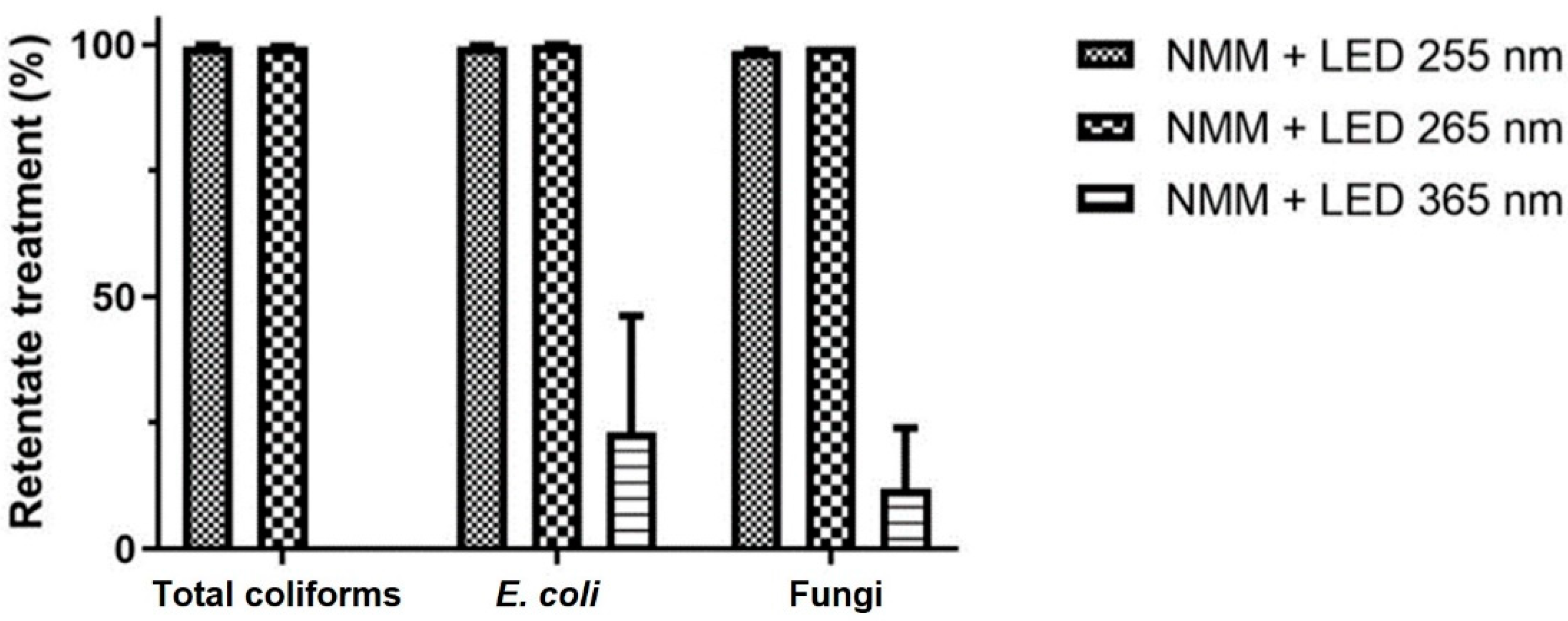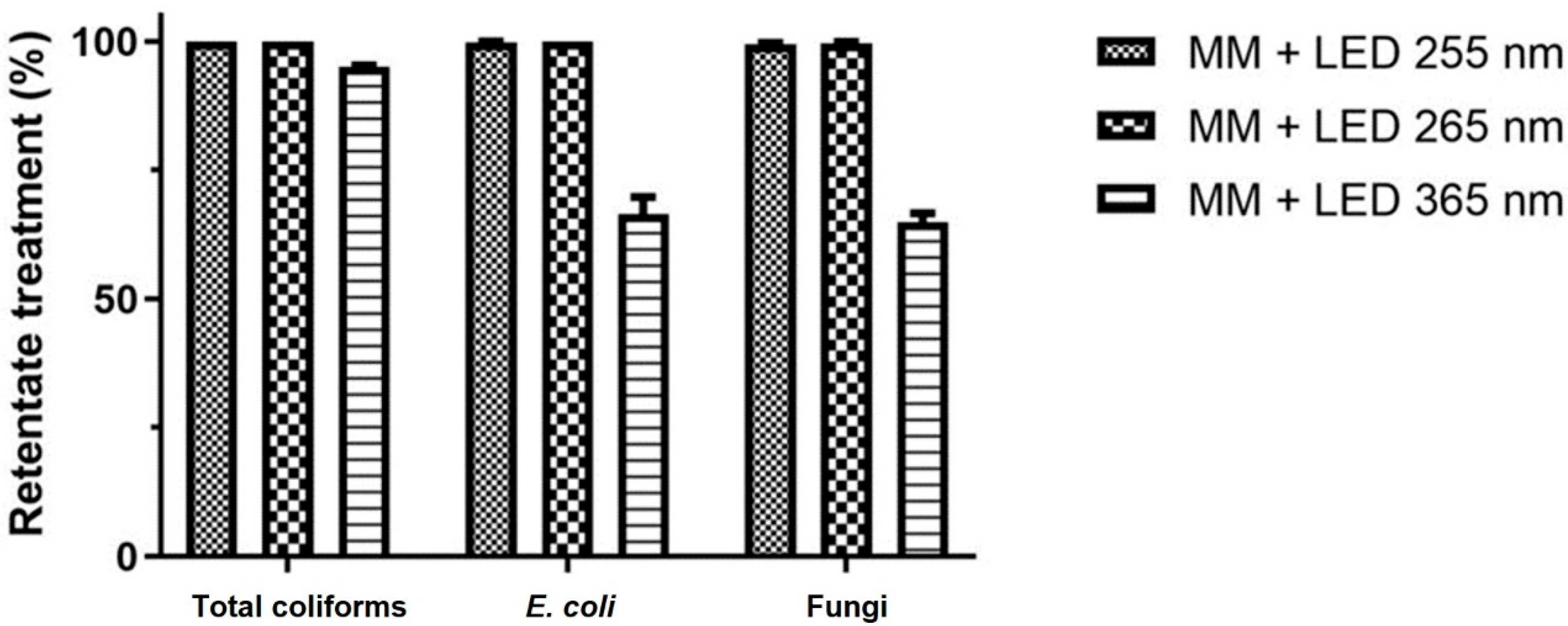Towards a Novel Combined Treatment Approach Using Light-Emitting Diodes and Photocatalytic Ceramic Membranes
Abstract
:1. Introduction
2. Materials and Methods
2.1. Matrix
2.2. Experimental Setup
- Test LEDs with different wavelengths without the use of photocatalytic surfaces (Figure S1a);
- Test the efficiency of filtration without light (Figure S1b) comparing non-modified silicon carbide membranes and photocatalytic membranes modified with silicon dioxide and titanium dioxide [17];
- Test both solutions, LEDs with different wavelengths combined with non-modified and modified membranes (Figure S1c).
2.2.1. Light-Emitting Diodes
2.2.2. Membrane Modification
2.2.3. Filtration Experiments with and without LED Inactivation
2.3. Methods for Detection of the Target Microorganisms
2.3.1. Bacterial Analysis
2.3.2. Mycological Analysis
2.4. Data Analysis
3. Results and Discussion
3.1. Experiments with Light-Emitting Diodes
3.2. Membrane Filtration
4. Conclusions
- -
- Three small LEDs that emit light at 255 and 265 nm achieved extremely high inactivation levels (higher than 2.5-log inactivation) of total coliforms and E. coli after 10 min of exposure in real wastewater effluents.
- -
- The combination of membrane filtration and LEDs that emit at 255 and 265 nm achieve an extremely high quality of permeate (water produced) while guaranteeing an extremely high treatment of the retentate, one of the issues associated with the membrane processes.
- -
- Even though a considerable permeability decrease was observed in the silicon carbide membranes modified with titanium dioxide and silicon dioxide, all the permeate samples were free from contamination with the fecal indicators. The combination of photocatalytic ceramic membranes modified using a solvent-free procedure with LEDs that emit light at higher wavelengths improved the retentate treatment due to the production of highly reactive oxygen species (retentate treatment percentages higher than 65% were obtained).
Supplementary Materials
Author Contributions
Funding
Conflicts of Interest
References
- Shannon, M.A.; Bohn, P.W.; Elimelech, M.; Georgiadis, J.G.; Mariñas, B.J.; Mayes, A.M. Science and technology for water purification in the coming decades. Nature 2008, 452, 301–310. [Google Scholar] [CrossRef] [PubMed]
- Hijnen, W.A.M.; Beerendonk, E.F.; Medema, G.J. Inactivation credit of UV radiation for viruses, bacteria and protozoan (oo)cysts in water: A review. Water Res. 2006, 40, 3–22. [Google Scholar] [CrossRef] [PubMed]
- Linden, K.G.; Shin, G.-A.; Lee, J.-K.; Scheible, O.K.; Shen, C.; Posy, P. Demonstrating 4-log Adenovirus Inactivation in a Medium-Pressure Ultraviolet Disinfection Reactor. J. AWWA 2009, 101, 90–97. [Google Scholar] [CrossRef]
- Linden, K.G.; Shin, G.; Sobsey, M.D. Comparative effectiveness of UV wavelengths for the inactivation of Cryptosporidium parvum oocysts in water. Water Sci. Technol. 2001, 43, 171–174. [Google Scholar] [CrossRef]
- Rosenfeldt, E.J.; Linden, K.G. Degradation of Endocrine Disrupting Chemicals Bisphenol A, Ethinyl Estradiol, and Estradiol during UV Photolysis and Advanced Oxidation Processes. Environ. Sci. Technol. 2004, 38, 5476–5483. [Google Scholar] [CrossRef]
- Keen, O.S.; Linden, K.G. Degradation of Antibiotic Activity during UV/H2O2 Advanced Oxidation and Photolysis in Wastewater Effluent. Environ. Sci. Technol. 2013, 47, 13020–13030. [Google Scholar] [CrossRef]
- Song, K.; Mohseni, M.; Taghipour, F. Application of ultraviolet light-emitting diodes (UV-LEDs) for water disinfection: A review. Water Res. 2016, 94, 41–349. [Google Scholar] [CrossRef]
- Jarvis, P.; Autin, O.; Goslan, E.H.; Hassard, F. Application of Ultraviolet Light-Emitting Diodes (UV-LED) to Full-Scale Drinking-Water Disinfection. Water 2019, 11, 1894. [Google Scholar] [CrossRef] [Green Version]
- Beck, S.E.; Suwan, P.; Rathnayeke, T.; Nguyen, T.M.H.; Huanambal-Sovero, V.A.; Boonyapalanant, B.; Hull, N.M.; Koottatep, T. Woven-Fiber Microfiltration (WFMF) and Ultraviolet Light Emitting Diodes (UV LEDs) for Treating Wastewater and Septic Tank Effluent. Water 2021, 13, 1564. [Google Scholar] [CrossRef]
- Song, K.; Taghipour, F.; Mohseni, M. Microorganisms inactivation by continuous and pulsed irradiation of ultraviolet light-emitting diodes (UV-LEDs). Chem. Eng. J. 2018, 343, 362–370. [Google Scholar] [CrossRef]
- Oliveira, B.R.; Barreto Crespo, M.T.; Pereira, V.J. Small but powerful: Light-emitting diodes for inactivation of Aspergillus species in real water matrices. Water Res. 2019, 168, 115108. [Google Scholar] [CrossRef]
- Oliveira, B.R.; Marques, A.P.; Asif, M.; Barreto Crespo, M.T.; Pereira, V.J. Light-emitting diodes effect on Aspergillus species in filtered surface water: DNA damage, proteome response and potential reactivation. Environ. Pollut. 2021, 287, 117553. [Google Scholar] [CrossRef]
- Gu, Q.; Ng, T.C.A.; Bao, Y.; Ng, H.Y.; Tan, S.C.; Wang, J. Developing better ceramic membranes for water and wastewater Treatment: Where microstructure integrates with chemistry and functionalities. Chem. Eng. J. 2022, 428, 130456. [Google Scholar] [CrossRef]
- Eray, E.; Candelario, V.M.; Boffa, V.; Safafar, H.; Østedgaard-Munck, D.N.; Zahrtmann, N.; Kadrispahic, H.; Jørgensen, M.K. A roadmap for the development and applications of silicon carbide membranes for liquid filtration: Recent advancements, challenges, and perspectives. Chem. Eng. J. 2021, 414, 128826. [Google Scholar] [CrossRef]
- Eray, E.; Boffa, V.; Jørgensen, M.K.; Magnacca, G.; Candelario, V.M. Enhanced Fabrication of Silicon Carbide Membranes for Wastewater Treatment: From Laboratory to Industrial Scale. J. Membr. Sci. 2020, 606, 118080. [Google Scholar] [CrossRef]
- Fujishima, A.; Rao, T.N.; Tryk, D.A. Titanium dioxide photocatalysis. J. Photochem. Photobiol. C Photochem. Rev. 2000, 1, 1–21. [Google Scholar] [CrossRef]
- Huertas, R.M.; Fraga, M.C.; Crespo, J.G.; Pereira, V.J. Solvent-Free Process for the Development of Photocatalytic Membranes. Molecules 2019, 24, 4481. [Google Scholar] [CrossRef] [Green Version]
- Fraga, M.C.; Huertas, R.M.; Crespo, J.G.; Pereira, V.J. Novel Submerged Photocatalytic Membrane Reactor for Treatment of Olive Mill Wastewaters. Catalysts 2019, 9, 769. [Google Scholar] [CrossRef] [Green Version]
- Cristóvão, M.B.; Bernardo, J.; Bento-Silva, A.; Ressureição, M.; Bronze, M.M.R.; Crespo, J.G.; Pereira, V.J. Treatment of anticancer drugs in a real wastewater effluent using nanofiltration: A pilot scale study. Sep. Purif. Technol. 2022; under review. [Google Scholar]
- Bolton, J.R.; Linden, K.G. Standardization of methods for fluence (UV dose) determination in bench-scale UV experiments. J. Environ. Eng. 2003, 129, 209–215. [Google Scholar] [CrossRef]
- Warden, P.S.; DeSarno, M.S.; Volk, S.E.; Eldred, B.J. Evaluation of Colilert-18 for detection and enumeration of fecal coliform bacteria in wastewater using the U.S. Environmental Protection Agency Alternative Test Procedure Protocol. J. AOAC Int. 2011, 94, 1573–1580. [Google Scholar] [CrossRef] [Green Version]
- Yakub, G.P.; Castric, D.A.; Stadterman-Knauer, K.L.; Tobin, M.J.; Blazina, M.; Heineman, T.N.; Yee, G.Y.; Frazier, L. Evaluation of Colilert and Enterolert Defined Substrate Methodology for Wastewater Applications. Water Environ. Res. 2002, 74, 131–135. [Google Scholar] [CrossRef] [PubMed]
- Pereira, V.J.; Fernandes, D.; Carvalho, G.; Benoliel, M.J.; San Romão, M.V.; Barreto Crespo, M.T. Assessment of the presence and dynamics of fungi in drinking water sources using cultural and molecular methods. Water Res. 2010, 44, 4850–4859. [Google Scholar] [CrossRef]
- Li, G.Q.; Wang, W.L.; Huo, Z.Y.; Lu, Y.; Hu, H.Y. Comparison of UV-LED and low pressure UV for water disinfection: Photoreactivation and dark repair of Escherichia coli. Water Res. 2017, 126, 134–143. [Google Scholar] [CrossRef]
- Sholtes, K.A.; Lowe, K.; Walters, G.W.; Sobsey, M.D.; Linden, K.G.; Casanova, L.M. Comparison of ultraviolet light-emitting diodes and low-pressure mercury-arc lamps for disinfection of water. Environ. Technol. 2016, 37, 2183–2188. [Google Scholar] [CrossRef]
- Foster, H.A.; Ditta, I.B.; Varghese, S.; Steele, A. Photocatalytic disinfection using titanium dioxide: Spectrum and mechanism of antimicrobial activity. Appl. Microbiol. Biotechnol. 2011, 90, 1847–1868. [Google Scholar] [CrossRef] [PubMed]
- Xiong, P.; Hu, J. Inactivation/reactivation of antibiotic-resistant bacteria by a novel UVA/LED/TiO2 system. Water Res. 2013, 47, 4547–4555. [Google Scholar] [CrossRef]
- Biancullo, F.; Moreira, N.F.F.; Ribeiro, A.R.; Manaia, C.M.; Faria, J.L.; Nunes, O.C.; Silva, A.M.T. Heterogeneous photocatalysis using UVA-LEDs for the removal of antibiotics and antibiotic resistant bacteria from urban wastewater treatment plant effluents. Chem. Eng. J. 2019, 367, 304–313. [Google Scholar] [CrossRef]
- Claro, E.M.T.; Bidoia, E.D.; de Moraes, P.B. A high-performance doped photocatalysts for inactivation of total coliforms in superficial waters using different sources of radiation. J. Environ. Manag. 2016, 177, 264–270. [Google Scholar] [CrossRef] [PubMed] [Green Version]
- Oliveira, B.R.; Sanches, S.; Huertas, R.M.; Barreto Crespo, M.T.; Pereira, V.J. Treatment of a real water matrix inoculated with Aspergillus fumigatus using a photocatalytic membrane reactor. J. Membr. Sci. 2020, 598, 117788. [Google Scholar] [CrossRef]



Publisher’s Note: MDPI stays neutral with regard to jurisdictional claims in published maps and institutional affiliations. |
© 2022 by the authors. Licensee MDPI, Basel, Switzerland. This article is an open access article distributed under the terms and conditions of the Creative Commons Attribution (CC BY) license (https://creativecommons.org/licenses/by/4.0/).
Share and Cite
Bernardo, J.; Sério, J.; Oliveira, B.; Marques, A.P.; Huertas, R.; Crespo, J.G.; Pereira, V.J. Towards a Novel Combined Treatment Approach Using Light-Emitting Diodes and Photocatalytic Ceramic Membranes. Water 2022, 14, 292. https://doi.org/10.3390/w14030292
Bernardo J, Sério J, Oliveira B, Marques AP, Huertas R, Crespo JG, Pereira VJ. Towards a Novel Combined Treatment Approach Using Light-Emitting Diodes and Photocatalytic Ceramic Membranes. Water. 2022; 14(3):292. https://doi.org/10.3390/w14030292
Chicago/Turabian StyleBernardo, Jorge, João Sério, Beatriz Oliveira, Ana Paula Marques, Rosa Huertas, João Goulão Crespo, and Vanessa Jorge Pereira. 2022. "Towards a Novel Combined Treatment Approach Using Light-Emitting Diodes and Photocatalytic Ceramic Membranes" Water 14, no. 3: 292. https://doi.org/10.3390/w14030292
APA StyleBernardo, J., Sério, J., Oliveira, B., Marques, A. P., Huertas, R., Crespo, J. G., & Pereira, V. J. (2022). Towards a Novel Combined Treatment Approach Using Light-Emitting Diodes and Photocatalytic Ceramic Membranes. Water, 14(3), 292. https://doi.org/10.3390/w14030292






